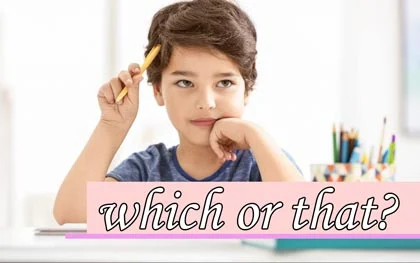Which or That? How to Use Them Properly
In last section, we’ve discussed about the difference of who and whom as relative pronoun. Now, we’re going to discuss about when to use which and that in a sentence. As we know, most English speakers or learners use which and that every day, both in written and spoken.
Although these words are obviously common as relative pronoun, but it doesn’t mean that they can be used easily. In certain clauses, these words may cause a lot of confusion. However, there’s an easy way to define whether it should use which or that in a sentence.
When to use which and when to use that in a sentence?
If the sentence doesn’t need the clause or the clause is simply removable, you should use which. If it does and the clause isn’t removable because it's an essential information that would change the meaning if removed, then use that.
What’s the difference between which and that in grammar?
Before we learn about when to use that or which, you need to understand about the type of relative clauses first. There are two types of relative clauses that you need to know in determining whether it should use which or that, they are defining clause and non-defining clause.To understand defining and non-defining clause, let's look at these two sentences below:
- My iPhone, which has red rubber case, is a Christmas gift from my father.
- My iPhone that has red rubber case is a Christmas gift from my father.
These sentences are actually not same. The first one tells us that the speaker has only an iPhone and it is a Christmas gift from his father. The phrase which has red rubber case only gives us additional information about the iPhone description, but it doesn’t make any change to the meaning. This phrase is called as non-defining (also called non-restrictive clause or non-essential clause) clause. So if you remove the clause, it would still be clear that the iPhone is a Christmas gift from his father.
While the second sentence here suggests that the speaker has more than one iPhone, but the iPhone with red rubber case is a Christmas gift from his father. The phrase that has red rubber case is known as defining clause (also called as restrictive clause or essential clause) because another part of the sentence (in this case the iPhone) depends on it. So if you remove the clause, you will change the meaning. The implication that he owns more than one iPhone would be lost, and even if you somehow already knew about the other iPhones, you wouldn’t know which one is as the Christmas gift from his father.
How to use which and that in a sentence?
Because non-defining clause simply adds description or removable information, you can use which if you want to add description or information to the subject without give any implication to the meaning. Here are some of the examples:
- The bridge, which was completed in 1965, is the best landmark in this city.
- Our room, which overlooks the ocean, costs more than the regular one.
- This antique vase, which is the most expensive stuff here, was made by an Italian craftsman in Middle Ages.
Meanwhile, the word that has a significant role to specify the noun (subject) the sentences. So, you can use that if your clause contains essential information about the noun and it affects the meaning of the sentence. Here are some of the examples:
- There is some equipment that I need to buy before starting the climbing.
- Mr. Henry has got a machine that can print names on badges in just few seconds.
- The person that lives next door is kind to me.
Both which and that are common words that look similar but have different usage. By identifying and determining your clause first whether it’s a restrictive or non-restrictive clause, you can easily pick which one suit best. You can find more useful topic about study English here on the index page of ContohText.
